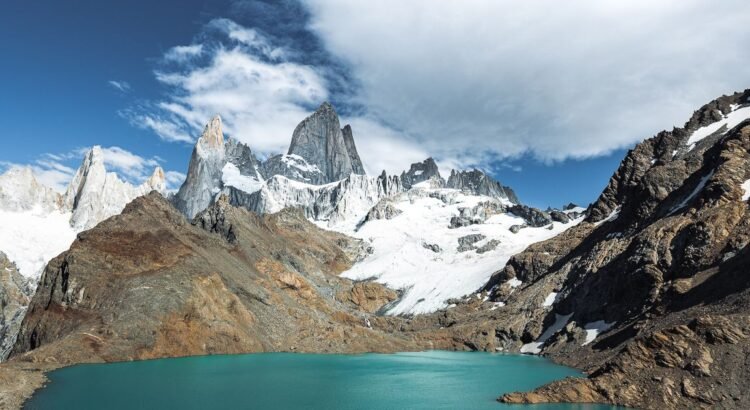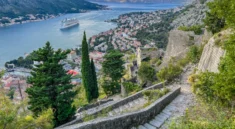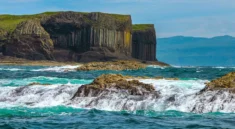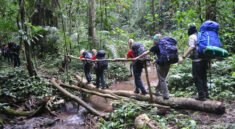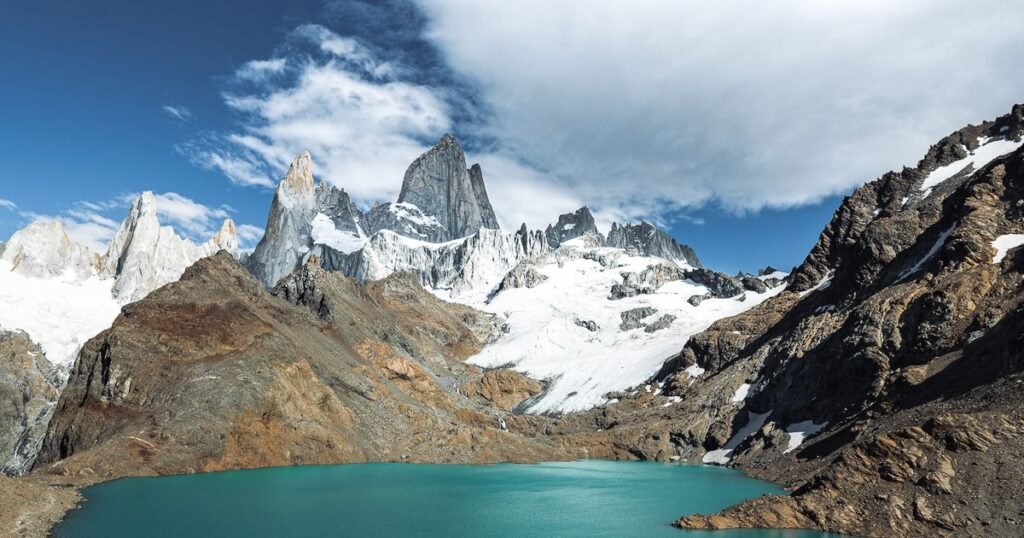
Far away from Argentina’s vibrant cities and crowded tourist routes lies a serene corner of Patagonia that stirs the soul and humbles the senses. El Chaltén, a tiny mountain town cradled in the southern Andes, is more than a destination—it’s a gateway to raw wilderness, a sanctuary for solitude seekers, and the kind of place that makes you forget your phone exists. Known as “Argentina’s Trekking Capital,” El Chaltén is where towering granite spires rise from the earth like stone cathedrals, and nature reigns in dramatic, unfiltered beauty.
El Chaltén is not for everyone—and that’s precisely its charm. There are no traffic lights, no luxury shopping streets, and no all-night party scenes. What it offers instead is peace, purity, and purpose. It’s a town for hikers, dreamers, mountaineers, and those yearning for a deeper connection with the natural world.
Arrival At The End Of The World
Reaching El Chaltén is an adventure in itself. Located in Santa Cruz Province, deep in Argentine Patagonia, the town is a three-hour drive from El Calafate, the nearest airport. The journey unfolds across vast Patagonian steppe, with guanacos and condors as your only companions, until the jagged silhouette of the Fitz Roy Massif appears on the horizon—abrupt and awe-inspiring.
As you enter the town, the landscape changes from arid plains to glacial rivers, forested hills, and vertical peaks. El Chaltén sits on the banks of the Río de las Vueltas, bordered by the Los Glaciares National Park, a UNESCO World Heritage Site. With a population of just over 1,500 people, the town has no real urban sprawl—just dirt roads, cozy lodges, craft beer pubs, and wooden signs pointing toward world-class trails.
A Hiker’s Heaven: Trails, Peaks, and Pure Solitude
El Chaltén is a town built around hiking. Here, the trailheads begin right outside your hostel or cabin door. You don’t need to drive to explore Patagonia’s wildest landscapes—they’re literally in your backyard.
The most famous trek is the Laguna de los Tres trail. A moderate-to-challenging 20-kilometer round-trip hike, it offers a close-up view of the iconic Mount Fitz Roy—a jagged granite monolith that has humbled climbers for decades. The last hour of the ascent is steep and rocky, but the reward is overwhelming: a glacial lake of impossible turquoise, with Fitz Roy rising like a sentinel behind it.
Other popular hikes include:
- Laguna Capri: A shorter, gentler hike with a stunning vantage point of Fitz Roy. Ideal for sunrise photography.
- Laguna Torre: A 9-hour round-trip trek leading to the base of Cerro Torre, another needle-like peak. You’ll walk through lenga forests, rivers, and glacial moraines before reaching the lagoon with floating icebergs.
- Loma del Pliegue Tumbado: A less-traveled route with panoramic views of both Fitz Roy and Cerro Torre. On clear days, you can see all the way to the Southern Patagonian Ice Field.
Each trail offers a different perspective, and all of them deliver that rare feeling of complete immersion in the wild—no billboards, no buildings, no crowds. Just wind, rock, ice, and sky.
The Majesty Of Mount Fitz Roy
Rising to 3,405 meters, Fitz Roy dominates the skyline and the imagination. Known to the native Tehuelche people as “El Chaltén,” or “smoking mountain,” because of the clouds that often swirl around its peak, this mountain is a sacred presence.
Climbers from around the world come to test themselves against Fitz Roy’s vertical granite walls, but for most visitors, simply seeing it in full clarity is a spiritual experience. The weather is notoriously fickle in Patagonia—rain, sun, snow, and high winds can happen in a single afternoon—so catching a clear view of Fitz Roy feels like winning the lottery of nature.
A Town That Breathes With Nature
El Chaltén may be small, but it is rich in character. Rustic wooden buildings line the unpaved streets, and the rhythm of life is dictated by daylight, weather forecasts, and trail conditions. Everyone—from the café baristas to the shop owners—has a story of a summit, a storm, or an encounter with a fox or condor.
Cafés serve strong Argentine coffee and hearty pastries to fuel hikers before sunrise. After long treks, cerveza artesanal (craft beer) flows in local breweries like La Cervecería or Don Guerra, where sweaty hikers trade stories over wood-fired pizzas. Small but delightful restaurants offer Patagonian lamb, trout from nearby rivers, and locally grown vegetables, creating a farm-to-table dining experience powered by wilderness.
Wi-Fi is unreliable, which is oddly liberating. In El Chaltén, you unplug not by choice, but by nature. It is a digital detox enforced by geography—and one most visitors come to appreciate deeply.
Off The Tourist Trail—But Not Alone
While Patagonia draws many visitors, El Chaltén has managed to remain off the main circuit. It lacks the infrastructure of Bariloche or the crowds of Torres del Paine. That means fewer bus tours, no luxury resorts, and a refreshing absence of commercialization.
Instead, you meet fellow travelers who are here for the same reason: the love of the mountains. Solo trekkers, nature photographers, long-distance hikers, and mountaineers mingle in the town’s few bars and hostels, often forming spontaneous trail partnerships or sharing camping gear.
The spirit here is collaborative and kind. Strangers help each other read weather charts. Locals give route advice freely. There’s a quiet, mutual respect among those who came seeking something deeper than an Instagram moment.
Local Wildlife And Biodiversity
El Chaltén lies in one of Argentina’s most ecologically rich regions. The Los Glaciares National Park is home to over 100 species of birds, including the majestic Andean condor, Magellanic woodpecker, and the rare rufous-tailed hawk. You may spot guanacos, red foxes, and even the elusive puma, though sightings are rare and thrilling.
The forests are dominated by lenga and ñire trees, which burst into vivid reds and yellows during the fall, turning the trails into living tapestries of color. Spring brings wildflowers and nesting birds, while summer offers long days and ideal hiking conditions.
Unlike other parts of the world where wilderness is diminishing, in El Chaltén, it feels alive and expansive, as though the land still holds secrets that humans haven’t yet unlocked.
Camping And Connection To The Land
For those who want a deeper experience, multi-day treks and camping routes are available, with designated campgrounds such as Campamento Poincenot or Campamento De Agostini. These offer basic facilities but unparalleled proximity to the peaks. Imagine waking up in a tent, unzipping the flap, and seeing the first rays of sunlight striking Fitz Roy’s pink granite face.
Camping here is not just about saving money—it’s about being part of the land, about sleeping under a sky untouched by light pollution, and about hearing the wind howl through the peaks like an ancient whisper.
Respecting Nature: Leave No Trace Culture
With great beauty comes great responsibility. El Chaltén practices and promotes Leave No Trace ethics. Hikers are expected to carry out all trash, stick to marked trails, avoid feeding wildlife, and use designated toilets or carry biodegradable waste bags.
Local guides and park rangers emphasize education and stewardship. The town thrives because the ecosystem remains healthy, and the locals are deeply protective of that balance.
Travelers here often leave changed—not just in muscle tone, but in mindset, carrying a deeper appreciation for Earth’s fragility and majesty.
Seasons And Best Time To Visit
The best time to visit El Chaltén is between November and March, the Southern Hemisphere’s summer. Days are long (up to 17 hours of daylight), and the trails are mostly clear of snow. However, weather remains unpredictable, and it’s always wise to dress in layers and prepare for rapid changes.
Autumn (April-May) paints the forests in fiery hues and brings fewer tourists. Winter sees the town mostly shut down, though hardcore mountaineers and photographers still brave the conditions for the solitude and icy splendor.
Leaving, But Never Letting Go
Departing El Chaltén is bittersweet. As you drive back along the solitary road toward El Calafate, the jagged silhouette of Fitz Roy in your rearview mirror seems to wave a silent goodbye—or perhaps beckon you to return. This is not a place you simply visit. It’s a place that etches itself onto your soul.
In a world saturated with curated travel and fast-paced itineraries, El Chaltén offers a rare antidote: stillness, authenticity, and awe. It reminds us what it means to move slowly, to listen deeply, and to walk—quite literally—off the beaten path.
For hikers, dreamers, and lovers of untamed beauty, El Chaltén isn’t just Patagonia’s best-kept secret—it’s a spiritual frontier.

